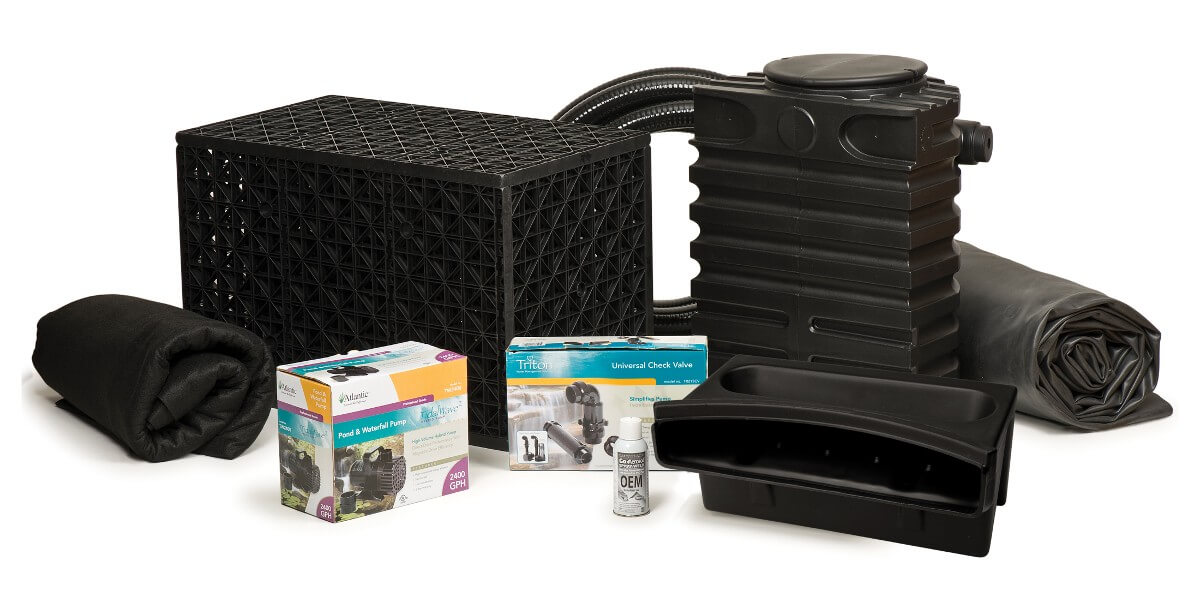A Water Feature Built for a Wild Animal
Published in PondTrade Magazine
One weekday afternoon, a customer came into our store inquiring about 
I took the time to explain the difference between a quality system and a homemade system, centering my factual points on routine maintenance, sustainability and reliability. For example, in a pond-free system, a five-gallon bucket can be used in place of a pump chamber, milk crates can be used in place of Eco-Blox and a sump pump with garden hose can be used to run the system and deliver water to the waterfall.
Of course, there are many downsides to using these types of products. Five-gallon buckets and milk crates do not maintain structural integrity under pressure, and we all know the disadvantages of sumps pumps and garden hoses. The power consumption of a sump pump is mind-boggling; many are oil-filled. And what happens to a garden hose when a rock is placed on top of it?
After communicating these few facts, the customer was receptive to exploring components composing a quality system. Before showing him products, I needed to ask about the application to recommend the appropriate system. I must admit, I was not prepared for the answer.
In 18 years of business, I have never sold a water feature for a cat…even an ordinary one. And this was no ordinary cat. Mia is an African serval.
For those wondering, African servals are medium-size cats native to Sub-Saharan Africa. Although they can be aggressive, Mia, in many ways, is no different than any other ordinary house cat. African servals tend to take to one person, similar to a parrot. In this case, Mia has taken to Cassie. Larry, on the other hand, has learned to deal with the cat’s instincts of swatting, clawing and pouncing. Mia can and will draw blood, so adequate care and caution must be taken when handling her.
Building a Habitat
In order to acquire an
Larry and Cassie went through all the necessary protocols, constructed a habitat and obtained certification to adopt Mia. Based on the natural habitat of the animal, not required by the government, they decided that Mia needed a water feature to finish off her habitat. African servals, being native to Sub-Saharan Africa, live along tributaries. African servals have the ability to swim, but rarely do so.
After discussing Mia, her natural habitat and maintenance expectations of the water feature with Larry and Cassie, we all decided that a pond-free system was the way to go for them and for Mia. We compared the pros and cons of a DIY, product-based solution versus a professionally designed system. I mentioned pump longevity, safety and energy consumption as well as future maintenance. They decided they needed a heavy-duty solution designed for a professional installer, but a system that was easy for them to install at the same time. We had the perfect solution in stock: the Oasis Pond-Free System manufactured by Atlantic Water Gardens.
More Pics of Mia are in our Photo Gallery
The Perfect System
Atlantic Water Gardens’ Oasis Pond-Free System comprises a heavy-duty compact pump chamber, Eco-Blox, a robust waterfall spillway, an auto-fill kit, 45-mil EPDM liner an
Maintenance
The next major obstacle was maintenance, in terms of water quality and overall appearance. As with any animal enclosure, there are waste 
We recommended the Triton Ionizer as well as a regimen consisting of Microbe-Lift PL and PondMarket Restor. The Triton Ionizer adds minerals to the water, dramatically decreasing organic buildup on rocks and coping of the water feature. Microbe-Lift PL eats up waste from Mia while naturally maintaining healthy water quality. Restor safely removes the remaining gunk buil
As of today, approximately five months later, Mia loves her tributary and Larry and Cassie love the low maintenance of the water feature. Even better, the tributary provides Mia with hours of rooting and exploring time while burning excess energy — without being destructive inside her enclosure.
